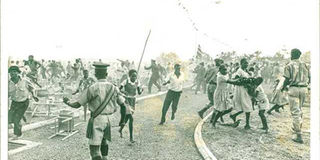Kenyatta regime covered up Kisumu massacre

Police disperse violent protestors in Kisumu Town during President Jomo Kenyatta's visit in 1969. PHOTO | FILE | NATION MEDIA GROUP
What you need to know:
- The TJRC removed the eyewitness oral account and memorandums out of its final report on the colonial and post-independence massacres.
- This tragic event marked the bloody triumph of Mzee Kenyatta’s ethnonationalism and infant crony capitalism over Pan-Africanism.
October 25, 1969 was a watershed in the history of independent Kenya.
However, what befell residents of Kisumu on that day and cast a long shadow over its postcolonial political and economic fortunes remains contested.
It’s an event that is often referred to as either “the Kisumu incident” or “the Kisumu massacre”.
Yet the shift from an “incident” to a “massacre” is not innocent semantics. It is a political choice.
Those who seek to downplay its significance in independent Kenya charitably call it the “Kisumu incident” or less charitably “the Kisumu riots”.
The only available monochromatic picture of President Jomo Kenyatta encircled by armed guards, pointing guns at the crowd, which included fleeing schoolchildren, amid a ground strewn with upturned chairs, circumstantially contradicts the official account of a Kisumu riot.
VARYING ACCOUNTS
However, the official account, which holds that “a large crowd of Luos reportedly menaced at Kenyatta’s security”, resulting in extrajudicial killings, as the Truth, Justice and Reconciliation Commission’s final report sees it, or “an overreaction by Jomo Kenyatta to show who was the boss”, as Kamau Ngotho wrote in last week’s Sunday Nation, is still being reproduced.
This is in spite of the contradicting accounts of the event rendered at the TJRC hearings in Kisumu.
Those who contest the official account and prefer to call it “the Kisumu massacre” see more in it.
They also think there are more questions than answers. And the questions are not answered by reproducing the transcript of Jomo Kenyatta’s petulant, incendiary, and misogynistic performance of hyper-masculinity vis-à-vis Jaramogi Oginga Odinga’s enraging, intrepid taunts and interjections during the official launch of “Russia Hospital” in Kisumu.
The event also needs to be put within a broader geopolitical context.
GEOPOLITICS
For example, why did Mzee Kenyatta, who disdained Soviet aid, and who had twice refused to open the New Nyanza Hospital, insist on presiding over the official opening ceremony of the then two-year-old hospital?
This is despite the warning by the provincial security team of the tension in the region wrought by the July 5 brazen assassination of Tom Mboya.
Why was it so urgent then? Who gave the shoot-to-kill order and when, if the presidential entourage knew well beforehand that they would drive into a hostile reception?
Why did the presidential security guards shoot people even in Awasi, at least some 50km away from the hospital?
What was the body count: was it the official 11 or at least 100 persons as B.A. Ogot and Raila Odinga separately estimate?
PAN-ETHNIC NATIONALISM
Who withheld the post-mortem reports on those killed and why? Who ordered the destruction of the photographic and film evidence of the event, except the often-reproduced single monochromatic photograph of the chaotic scene, by Mohammed Amin, and Satwant Matharoo’s film footage, which WTN showed the British audience?
These questions remain unanswered. TJRC removed the eyewitness oral account and memorandums out of its final report on the colonial and post-independence massacres.
Yet the event was more than a dust-up between two patriarchs. The tragic official opening of the first phase of the three-phase USSR-funded hospital and a medical school complex, a 10,000 irrigation scheme from Kano to Lower Nyakach and a polytechnic, which were all stopped after the incident, also represented the struggle for the soul of post-independence in the global chessboard of Cold War politics.
This tragic event marked the bloody triumph of Mzee Kenyatta’s ethnonationalism and infant crony capitalism over Pan-Africanism, Kenya’s pan-ethnic nationalism and various shades of socialism.
The author is a Kisumu-based political analyst.




